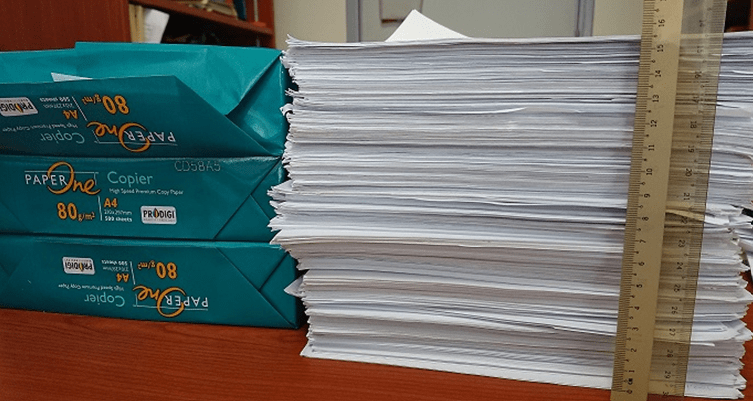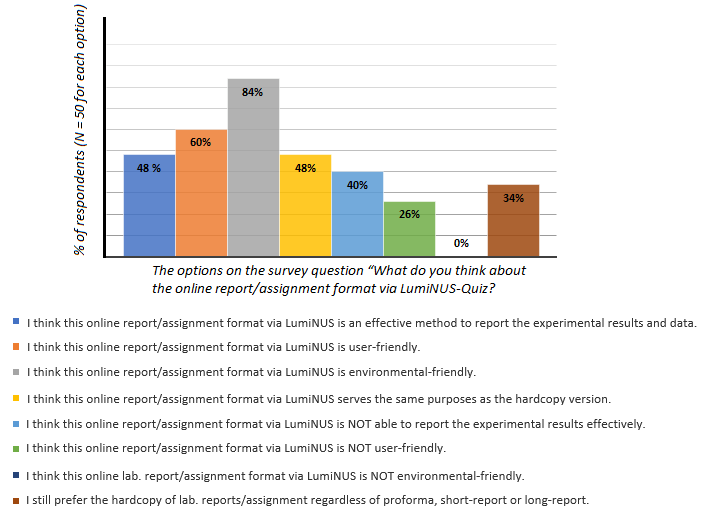CHAN Sau Han, Edith
Department of Chemistry, Faculty of Science (FoS)
Edith shares the benefits and limitations of using the “Quiz” function in LumiNUS (abbreviated as LumiNUS-Quiz) for the online Chemistry proforma laboratory report, discusses the findings on students’ perceptions and concerns regarding such an online report format, and shares her observations of students’ performance.

Recommended Citation Chan, E. S. H. (2021, June 9). Use of LumiNUS-Quiz as a platform for the online undergraduate Chemistry proforma laboratory report in practical classes. Teaching Connections. https://blog.nus.edu.sg/teachingconnections/2021/06/09/use-of-luminus-quiz-as-a-platform-for-the-online-undergraduate-chemistry-proforma-laboratory-report-in-practical-classes/
Proforma is a laboratory report format commonly used in practical courses. Conventionally, students complete a hardcopy or softcopy (in pdf or Word format) proforma report prepared by the lecturers and uploaded to the learning platform. Once students have completed the proforma report, they submit their copies either to the laboratory (for hardcopies) or upload it to the designated learning platform (for softcopies or scanned hardcopies) by the deadline. Upon submission, time was required to check these reports1.
With LumiNUS-Quiz, it not only reduces time spent on logistics, students also hone their writing skills, including making statements more concise, and providing clear explanations of scientific concepts and expressions. Students can also hone their higher-order thinking skills (analysis, evaluation, creation) (Bloom, 1956; Anderson & Krathwohl, 2001), by analysing and evaluating observations and experimental data to build relationships between the theories and their lab practicals.
Another advantage of using LumiNUS-Quiz is being able to maintain consistent grading by extracting and sorting answers in an excel spreadsheet for the same question and grading multiple questions at once, which would otherwise be difficult to do when manually grading conventional hardcopy or scanned softcopies of the proforma report. Fair grading is modulated by consistent grading (Close, 2009), and enhances students’ motivation and learning (McDonald, 2016).
During Semester 1 of AY2020/21, the online proforma laboratory report format (see Appendix for a sample) was implemented via LumiNUS-Quiz in an inorganic experiment in CM3291 “Advanced Experiments in Organic and Inorganic Chemistry”2 (Class size = 51). Due to the pandemic and safe-distancing measures, we adopted a hybrid practical teaching mode comprising hands-on and virtual practical classes. Each student submitted two online proforma reports to LumiNUS-Quiz for a two-(lab)session inorganic virtual practical. The following sections discuss the findings on students’ perceptions and concerns regarding the online format. The survey was held via LumiNUS before the submission deadline in Week 11; the survey’s participation rate was 98% (N = 50) without any incentive offered.
On the survey question, “What do you think about the online report/assignment format via LumiNUS-Quiz? (More than one option can be selected)”, the responses were analysed based on the percentage of respondents and percentage of options selected in Figures 1 and 2 respectively.
In Figure 1, most respondents (84%; 42 of 50 respondents) agreed that using LumiNUS-Quiz was environmental-friendly, while 60% found it user-friendly. Almost half (48%) also found the online proforma report effective in reporting experimental results and data, and served the same purpose as hardcopies. Such results were consistent to the responses obtained (0%, 26%, 34% and 40%) on negative options in Figure 1, where nil respondents found the online proforma reports environmentally-unfriendly.

N=50 for each option. The responses were based on the percentage of respondents on each perception option.
The results are reflected more significantly in Figure 2, where 71% of option selections (120 of 170 options selected by 50 respondents) showed positive responses, that is, putting the online proforma report on LumiNUS-Quiz was effective in reporting the experimental results and data, was user- and environmentally-friendly, and served the same purposes as hardcopies. The remaining 29% of option selections showed respondents’ reluctance towards the online proforma report. More importantly, only 10% of total options selected (17 of 170 options) indicated a preference for traditional hardcopies, implying strong student acceptance and support towards LumiNUS-Quiz as a platform for the online proforma report.

N=170; selected by 50 respondents. The responses were based on the percentage of options selected on each perception option.
The survey also included a qualitative question asking students for other comments about the online format. Only half (25 of 50 respondents) provided specific comments, and only 32% highlighted concerns regarding the online proforma report. These comments can be categorised thus:
Having difficulty using the equation, ChemDraw, diagram, subscripts and superscripts in LumiNUS-Quiz (26%);
Finding it inconvenient to constantly switch tabs in LumiNUS-Quiz (2%);
Preferring the hardcopy version (4%).
The main concern qualitatively highlighted related to intrinsic technical features in LumiNUS-Quiz, including the limitations of using this platform for laboratory reports.
Practically, their concerns did not significantly impact their performance in the two online proforma reports submitted. Figures 3 and 4 show screenshots of selected students’ work on the online reports in LumiNUS-Quiz in which all calculations, chemical formulae and equations were well-expressed and there was no issue for my report marking. All 102 online proforma reports were submitted within the deadline, and the grades and specific comments for all online proforma reports were individually distributed to students in Week 12 via LumiNUS-Gradebook, a week before CM3291’s final online test. As the two online proforma reports carried 10% of total assessments in CM3291, students could appeal the grade or request further clarification on comments given. Only one student (out of 51) sought clarification, and we did not receive any request to appeal report grades. This implied that this assessment platform and method should be clearly understood by students. We also did not receive negative comments regarding this method in the end-of-semester student feedback exercise.


Overall, students responded positively towards using LumiNUS-Quiz as a platform for the proforma report in chemistry practical classes. As a lecturer with extensive experience teaching CM3291, I also observed no negative impact on the quality of students’ lab reports and final written test performance, when the online proforma reports were used.
In conclusion, LumiNUS-Quiz can be an alternative platform for online lab reports without negative impact in a practical module’s learning outcome, especially during the current pandemic.
 |
Edith S. H. CHAN is a Senior Lecturer at the Department of Chemistry, NUS. She has interests in blended teaching and learning methods, and developments of teaching and learning tools and methods to enhance teaching, learning and assessments. She has previously applied and evaluated the blended teaching and learning methods in a Chemistry module with the financial support granted by the NUS Learning Innovation Fund Technology-Internal Blended Learning Online Courses (LIFT-iBLOC) programme in 2017. Edith can be reached at e.chan@nus.edu.sg. |
Endnotes
- These include checking for missing reports, opening the files individually for marking if softcopy submissions were used, and reading the answers written in various handwriting styles in the hardcopies etc.
- CM3291 is a compulsory practical module for all NUS Chemistry majors, and is offered during two regular semesters and one of the special semesters every academic year.
References
Anderson, L. W., Krathwohl, D. R., Airasian, P. W., Cruikshank, K. A., Mayer, R. E., Pintrich, P. R., & Wittrock, M.C (2001). A taxonomy of learning, teaching, and assessing: A revision of Bloom’s taxonomy of educational objectives. New York, NY: Longman.
Bloom, B. S. (1956). Taxonomy of educational objectives: The classification of educational goals. Handbook 1, Cognitive Domain. New York: Longmans, Green.
Close, D. (2009). Fair Grades. Teaching Philosophy. 32(4), 361-398. https://doi.org/10.5840/teachphil200932439
McDonald, D. (2016). Grading and providing feedback: Consistency, effectiveness, and fairness. The Center of Teaching and Learning, Wiley. https://ctl.wiley.com/grading-and-providing-feedback-consistency-effectiveness-and-fairness/
LumiNUS, Centre for Instructional Technology (CIT), NUS. http://cit.nus.edu.sg/luminus/
Appendix
Screenshot of one of the online proforma lab reports for Inorganic Experiments 2 in CM3291 “Advanced Experiments in Organic and Inorganic Chemistry” in Semester 1, AY2020/21.


